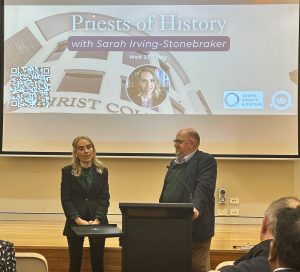
Sarah Irving-Stonebraker speaks with GSC’s John McClean at a recent event. (Pic: Cam Clausing)
by John McClean
Connecting with and passing on the history of our faith is often overlooked by the 21st century church. However, the church, even the Presbyterian church should be prepared to engage.
Last week GS&C and Christ College hosted a fascinating evening with Sarah Irving -Stonebraker, who raised the importance of Christians “tending and keeping” our history. By “tending”, she means understanding our history – including the good moments and the shameful – and by “keeping”, the protecting and passing down of our heritage.
We can and should do this because God works through history and Christianity is a historical faith, not only grounded in biblical history but also passed on through the generations.
Read Dr Irving-Stonebraker’s book Priests of History for her full argument on the importance of history. There’s also a good summary of it in this interview last year. Part of her call to action is the need for churches to connect with history. Dr Irving-Stonebraker suggests a few strategies for that.
It got me thinking about further practical steps we can take, including as Presbyterians. Remember, we are part of the Catholic Church. Our heritage does not begin in 1977, nor does it begin with John Dunmore Lang or even the Scottish Reformation. We are part of God’s big story, which is grounded in Israel and flows from the Day of Pentecost to reach the nations. We don’t have to focus solely on “Presbyterian” history, though we certainly should not ignore that.
So how can we help our churches connect with their history?
The obvious first step is to tell stories. Use historical illustrations in sermons. There are wonderful and terrible stories that can inspire and challenge. Talk about Maximus the Confessor who was ready to be mutilated for the sake of the gospel truth of a right view of Jesus, the Puritan preachers who went to London to preach during the plague of 1665 while lots of people were escaping the city, and 19th century missionaries who faced loneliness and death to bring the gospel to the nations. Don’t ignore the bad stories: Southern American Presbyterians supporting slavery, Scottish and Australian churches becoming liberal and German Christians cooperating with the Nazi regime.
Include a church history spot in the church service from time to time. A few weeks ago we said the Nicene Creed at church, and I gave a one-minute historical introduction. You can do that with other creeds and confessions, and with hymns. If you have a “Kid’s Talk” at church, why not occasionally make that about church history connected to a Bible truth.
Catechisms are an important part of the Reformed tradition that can be part of worship. The Heidelberg Catechism is especially suitable, but the Westminster Catechism works. Add a little bit of historical context, so people appreciate what the document is, as well as what it teaches.
Hymns are one of the best connections with previous generations of believers. Our congregational repertoire can be wider than the music of the 2000s (or the 1990s). Sing some of the great congregational praise of the past. There are good resources which give some of the history of hymns, so it’s easy to include some of this. Psalmody has also been a standard part of Presbyterian worship — so include that, even using some of the classics from the Scottish Psalter.
Sarah Irving-Stonebraker spoke about using the Book of Common Prayer. As catholic Christians, we can appropriate the prayer book tradition. There are also liturgical resources in the Presbyterian and Reformed tradition.
The Westminster Directory of Public Worship was never meant to be like a prayer book and it opens with an explanation of why the Westminster Divines were leaving the BCP behind. It is designed to be general guide to worship. Our congregations will probably not be blessed by 17th-century-length prayers. (The sample prayer in the Directory would be about 15 minutes long — but preachers in the Assembly often led public prayers for an hour or more). We won’t simply reproduce the directory, and that is not its purpose: it can be an inspiration for worship that reflects our communion with the saints of the past. Reformation Worship: Liturgies from the Past for the Present, edited by Jonathan Gibson and Mark Earngey, is an excellent source. The resources from our own PWAD also include a range of historical prayers.
The sense of connection with the prayer of previous generations is why The Valley of Vision is such a popular resource. Fifty years ago, Arthur Bennett, a Church of England minister who loved Puritan theology and practice published this collection of prayers drawn from Puritan authors, somewhat rewritten. Lots of us have found these helpful in personal devotions and as a basis for corporate prayer. You can see some of the prayers here. Recently, Johnny Gibson’s collections Be Thou My Vision: A Liturgy for Daily Worship, O Sacred Head, Now Wounded: A Liturgy for Daily Worship from Pascha to Pentecost, O Come, O Come, Emmanuel: A Liturgy for Daily Worship from Advent to Epiphany; Piercing Heaven: Prayers of the Puritans (R Elmer, ed), and Psalms in 30 Days (T. Wax ed) have offered something similar.
History local and global
Beyond worship, why not run an occasional church history seminar, or suggest Growth Groups use a video series to look at some history. One church holds an annual church history weekend with a couple talks on Saturday afternoon and evening and a relevant sermon on Sunday. Sarah Irving-Stonebraker suggests a book club reading some biographies or history. That can be a one-off or for a short season.
It is worth exploring your local history and sharing a bit about that. If your building has some history (and once a building exists it has a history!), highlight that rather than ignoring it. Who built it? Why? If you have a local historian in the congregation, ask them to do some research. Lots of churches have written a history booklet at some stage. If you can find an old one, update it and republish it, highlighting God’s work through the gospel through his people.
Our church building at Winmalee is about 40 years old and a few months ago we found an old video which was made to promote the church as a “project charge” for support around the Presbyterian church in NSW. It was great fun to see the building and people from 40 years ago, including familiar, though much younger ,faces! It was also inspiring to see how we continue with the gospel mission which inspired them.
We don’t connect to our history in order to live in a museum or to simply replicate the past. If you know any history, you know that things change. The biblical view of history is God’s story with a beginning, middle and end — things move on. We connect with history to help us live now on the basis of God’s presence and faithfulness in the past and the future.
